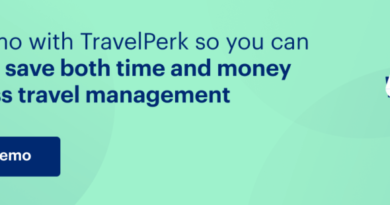A quick guide to understanding business travel analytics
What if your company could easily understand past and current travel trends, find correlations between different factors affecting business travel performance, and make predictions based on patterns in existing business travel data?
How could these insights improve your global business travel programs?
The field of collecting and analyzing data to optimize your company’s business travel strategy is called business travel analytics.
By using insights to make data-driven decisions, your organization can better manage travel expenditures, identify cost-saving opportunities, and improve overall business performance.
Investing in business travel analytics solutions is a great way to get ahead of competitors and streamline your business travel activities.
The business travel analytics process
The first step to take during the analytics process is to collect the necessary data. Business travel analysts must define the relevant KPIs and metrics, and then gather data on those from internal and external sources.
Next, they must use data analytics techniques to understand the data, create visualizations, and identify trends. These techniques may include descriptive travel analytics (data visualizations, spreadsheets, or descriptive statistics), diagnostic analytics (understanding how travel trends impact business performance), and predictive analytics (using machine learning and deep learning algorithms to identify patterns and predict future trends).
Finally, they can use the insights gained during this process to draw conclusions and take the next steps to optimize business travel spending.
Discover how TravelPerk helps your business travel analytics today!
Key metrics in business travel analytics
Business travel analytics involves analyzing data across several fields. These metrics and KPIs are useful for better understanding trends and patterns in business travel. They include:
- Travel spend: Where, how, and when is money being spent on business travel? Are there ways your company can optimize travel spend?
- Travel volume: How many trips are being taken? Does this vary over time? What are the transport methods being used (train, plane, etc.?)
- Average trip cost: How much money do travelers spend on their business trips? What are the primary business travel cost centers?
- Savings achieved: Are there any cost leakages or savings opportunities to identify?
- Compliance rate: Are travelers complying with the company’s business travel policies? Do they understand the policies, and are they able to easily access them?
- Traveler satisfaction: Are employees’ needs being satisfied when they travel? Are they happy with their business travel experience? How do they rate it?
Other important dimensions of data analysis
Not only is it important to understand key cost centers, it’s also useful to know how travelers are getting around. This means evaluating:
- Booking patterns: When and how are travelers booking? What are they booking (hotels, trains, flights?)
- Travel destinations: Where are people headed? Does this change over time or by region?
- Preferred airlines/hotels: Which airfares and hotels do travelers prefer to book? Are there certain options your company would like travelers to use (because they are cost-effective, environmentally-friendly, your company has a relationship with the vendor, etc.?)
Seasonal variations: Do travel patterns vary over time, yearly, or by season?
Advantages of business travel analytics
Business travel analytics can help companies improve their travel processes and streamline their operations in a number of ways. Here are some of the main advantages of this field of analysis:
- Improve travel policy compliance: Detect trends of policy violation, identify reasons for them, and curb overspending.
- Save money: Find out why and when trips are being canceled or booked last-minute.
- Improve employee satisfaction: Understand when and how employees like to book travel, and adjust business travel programs accordingly.
- Create more accurate travel budgets: Make accurate forecasts and improve return-on-investment.
- Identify optimal vendors: Choose the best vendors for your business needs, according to travel cost considerations and discounts offered.

How travel technology can support companies with business travel analytics
Business travel analytics is very useful, but launching a successful analytics program requires the right resources (such as time, and staff with specialized skills). Fortunately, there are many technologies in the business travel industry that can make the process easier.
Travel management software is designed to help companies with their business travel programs. It allows organizations to save time and money by managing their business travel through a centralized platform.
Corporate travel solutions can take the difficulty out of business travel by taking care of booking, travel policies, duty-of-care, business travel expense reporting, sustainability, and more.
Many corporate travel management software platforms have analytics functions to support companies in better understanding business travel patterns and practicing informed decision-making.
For example, TravelPerk offers a best-in-class business travel management reporting solution. With the TravelPerk software, companies will have access to:
- Advanced travel and expense dashboards: With flexible reporting, users can break data down by person, transport type, booking type, cancellations, recoverable VAT, and more. They can configure and schedule reports or alerts focusing on the data they need to make informed decisions, and then export those reports to give other teams and stakeholders a visual overview of where money is being spent, as well as their carbon emissions output.
- VAT insights: Users can generate reports based on recoverable VAT, and predict the potential end-of-year savings from looking after VAT spend.
- Account management: Premium TravelPerk account holders get access to an account manager to help tailor reports, read data, and make cost-saving financial decisions.
- Breakdown by cost: TravelPerk reports offer the option to break everything down by cost in a single visual. Users can see how budgets are distributed between teams, transport, business trip locations, and more.
- Travel restriction alerts: To help travel managers control risk, the TravelCare solution offers updates and alerts on healthcare guidelines, airstrikes, travel risks, and more. Both travel managers and travelers will receive automatic updates, saving time and money.
- Carbon emissions reporting: With GreenPerk, businesses can offset CO2 emissions spent on business travel. The GreenPerk carbon footprint report is downloadable, and users can configure alerts when a company reaches goals. The report offers a clear overview of a business’s CO2 emissions by flight routes and hotel stays, as well as the cost spent on offsetting carbon emissions.
- Interactive map: Travel managers can stay up-to-date on an entire teams’ business trip progress in real-time via an interactive map.
In addition
Users will benefit from all the other features of TravelPerk, including an integrated online booking tool, an extensive travel inventory, travel alerts and safety information, and 24/7 world-class customer support with target 15-second response time. TravelPerk has been rated the leading travel management company on user review platform G2.





